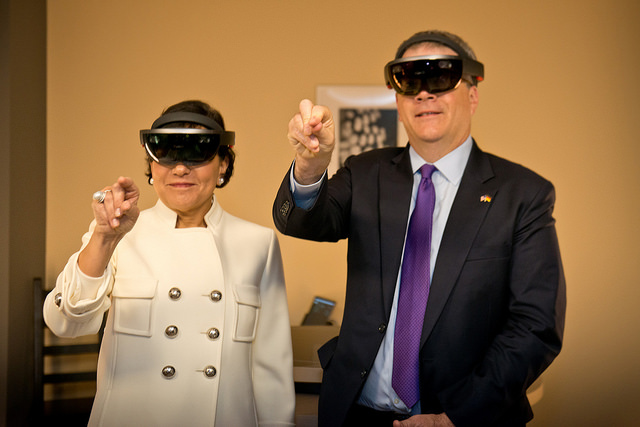
Attribution: US Dept of Commerce, HoloLens demo at Microsoft’s HM16 booth | U.S. Department of Commerce | Flickr
a project that runs smoothly & safely and makes money for everyone involved.
On a design level- my litmus test is whether it still looks good and works properly in 10 years’ time (unfortunately, too many projects appearing in glossy architecture magazines fail this test)
A construction project, with quality documentation so everything fits together properly, budget and program are achieved (or improved upon), construction is efficient & safe and there are not any acrimonious legal disputes at the end between client, designers, contractor and subcontractors is an elusive beast.
Construction projects have a propensity to run way over budget and program. This is coupled with quite small profit margins even for successful projects; and almost unlimited losses when it goes bad as I explain in BIM: Making Money
In my posts Tech is the easy bit, Beware the technology magpie & Success is not guaranteed I’ve covered the tendency to focus just on technology, and to assume business success will automatically follow.
I have had a number of discussions that go something like this:
(where I am the questioner. You could substitute ‘goggles’ with the latest thing)
Q: How is BIM going to make us money ?
A: Dunno, but I’ve got some really cool 3D goggles. People will try them and suddenly realise BIM is brilliant. Of course it will make money.
Q: What is your BIM business strategy i.e how are you going to develop capabilities, upskill staff, implement new processes etc.
A: Dunno, but I’ve got some really cool 3D goggles…….
Q: What are your opportunities and risks with BIM/digital engineering ?
A: We might be able to see some with these really cool 3D goggles …..?
Q: What is the impact of digital technologies on our employees and business partners such as consultants & subcontractors ?
A: Er, not sure. Did I tell you I have some really cool 3D goggles ?
And so on.
Ask the right question
To my mind, the question to ask is:
Q: How will we apply this technology to benefit our business ?
So in the case of the goggles- the potential uses might be:
- winning work
- identifying design issues- either errors or potential improvements
- detailed services coordination
- ‘safety in design’ or constructibility reviews
- value engineering or cost optimisation
- analysis- such as natural lightning, disabled access, sight-lines, signage visibility etc
- marketing & promotion
It might seem obvious, but many organisations believe they “do BIM” by having a few toys. Ask what their strategy, plan and approach is- you’ll get a blank response.
I like 3D goggles as much as the next BIM geek, but only if part of this broader strategy.
If there is no strategy and the main focus of a business or output of ‘BIM’ is on token efforts, gadgetry or superficial uses, then it is most likely a waste of time and money.


You must be logged in to post a comment.